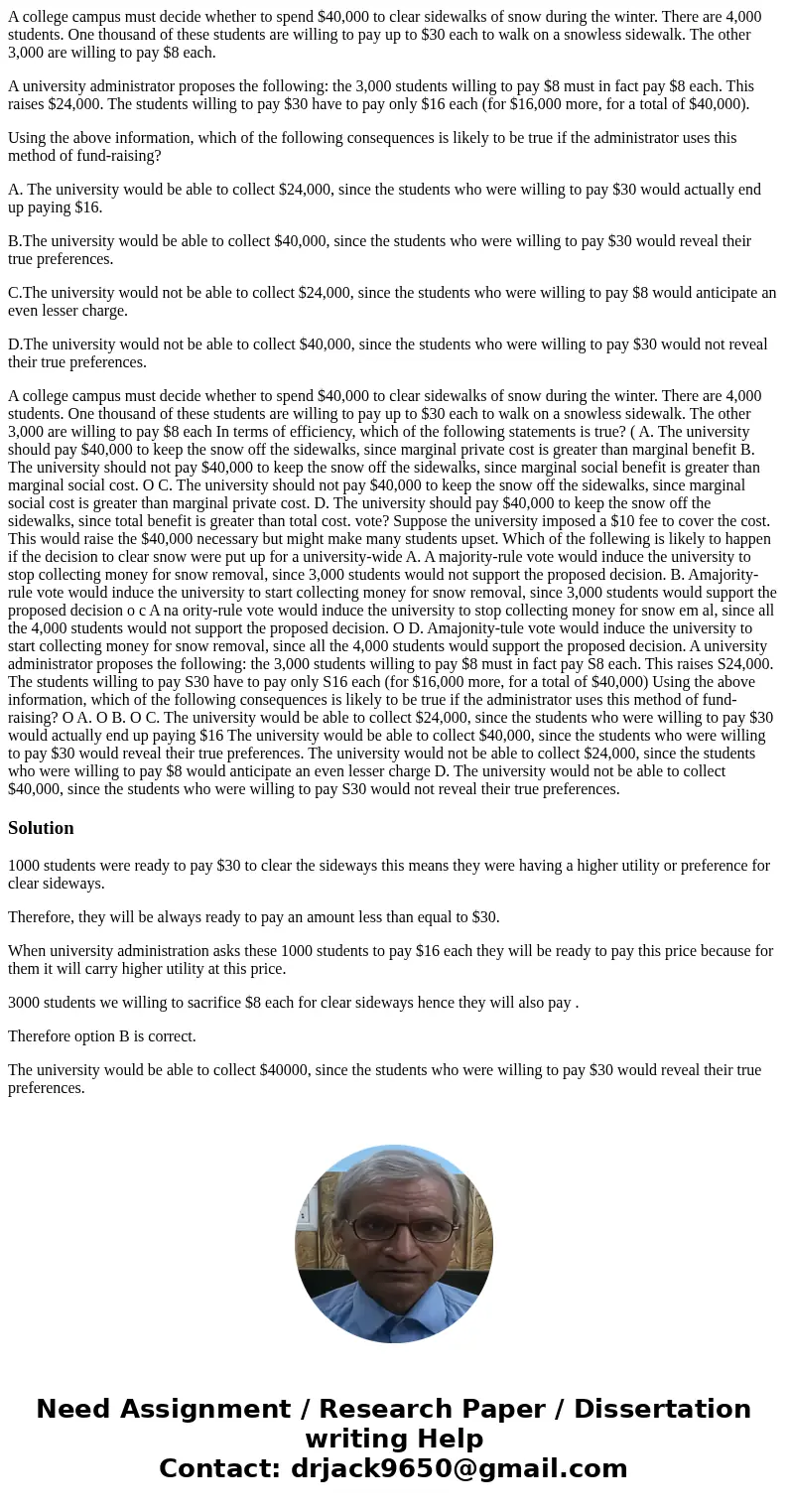A college campus must decide whether to spend 40000 to clear
A college campus must decide whether to spend $40,000 to clear sidewalks of snow during the winter. There are 4,000 students. One thousand of these students are willing to pay up to $30 each to walk on a snowless sidewalk. The other 3,000 are willing to pay $8 each.
A university administrator proposes the following: the 3,000 students willing to pay $8 must in fact pay $8 each. This raises $24,000. The students willing to pay $30 have to pay only $16 each (for $16,000 more, for a total of $40,000).
Using the above information, which of the following consequences is likely to be true if the administrator uses this method of fund-raising?
A. The university would be able to collect $24,000, since the students who were willing to pay $30 would actually end up paying $16.
B.The university would be able to collect $40,000, since the students who were willing to pay $30 would reveal their true preferences.
C.The university would not be able to collect $24,000, since the students who were willing to pay $8 would anticipate an even lesser charge.
D.The university would not be able to collect $40,000, since the students who were willing to pay $30 would not reveal their true preferences.
A college campus must decide whether to spend $40,000 to clear sidewalks of snow during the winter. There are 4,000 students. One thousand of these students are willing to pay up to $30 each to walk on a snowless sidewalk. The other 3,000 are willing to pay $8 each In terms of efficiency, which of the following statements is true? ( A. The university should pay $40,000 to keep the snow off the sidewalks, since marginal private cost is greater than marginal benefit B. The university should not pay $40,000 to keep the snow off the sidewalks, since marginal social benefit is greater than marginal social cost. O C. The university should not pay $40,000 to keep the snow off the sidewalks, since marginal social cost is greater than marginal private cost. D. The university should pay $40,000 to keep the snow off the sidewalks, since total benefit is greater than total cost. vote? Suppose the university imposed a $10 fee to cover the cost. This would raise the $40,000 necessary but might make many students upset. Which of the follewing is likely to happen if the decision to clear snow were put up for a university-wide A. A majority-rule vote would induce the university to stop collecting money for snow removal, since 3,000 students would not support the proposed decision. B. Amajority-rule vote would induce the university to start collecting money for snow removal, since 3,000 students would support the proposed decision o c A na ority-rule vote would induce the university to stop collecting money for snow em al, since all the 4,000 students would not support the proposed decision. O D. Amajonity-tule vote would induce the university to start collecting money for snow removal, since all the 4,000 students would support the proposed decision. A university administrator proposes the following: the 3,000 students willing to pay $8 must in fact pay S8 each. This raises S24,000. The students willing to pay S30 have to pay only S16 each (for $16,000 more, for a total of $40,000) Using the above information, which of the following consequences is likely to be true if the administrator uses this method of fund-raising? O A. O B. O C. The university would be able to collect $24,000, since the students who were willing to pay $30 would actually end up paying $16 The university would be able to collect $40,000, since the students who were willing to pay $30 would reveal their true preferences. The university would not be able to collect $24,000, since the students who were willing to pay $8 would anticipate an even lesser charge D. The university would not be able to collect $40,000, since the students who were willing to pay S30 would not reveal their true preferences.Solution
1000 students were ready to pay $30 to clear the sideways this means they were having a higher utility or preference for clear sideways.
Therefore, they will be always ready to pay an amount less than equal to $30.
When university administration asks these 1000 students to pay $16 each they will be ready to pay this price because for them it will carry higher utility at this price.
3000 students we willing to sacrifice $8 each for clear sideways hence they will also pay .
Therefore option B is correct.
The university would be able to collect $40000, since the students who were willing to pay $30 would reveal their true preferences.

 Homework Sourse
Homework Sourse